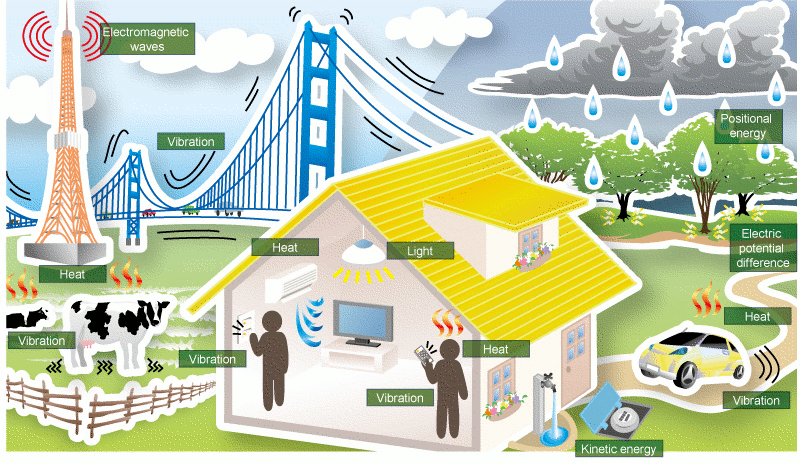Embedded systems without batteries nor connection to the mains, is that possible ? The answer is Yes!. For ultra low-power devices, Power Harvesting (aka Energy Harvesting) may be an option.
By harvesting the energy from vibration from people walking or cars crossing bridges, automobile heat, broadcasting waves, light, wind, etc.. it is possible to capture enough energy to power very small devices such as wearable electronics and wireless sensor networks.
The illustration below show the multitudes of tiny sources of energy around us.

Please refer to the table below to see what amount of energy might be harvested depending on the source.
| Energy Source | Examples | Energy per unit area |
| Vibration | Walking, motors, bridges | 10-3 to 10-4 W/cm2 |
| Light | Lighting, sunlight inside rooms | 10-4 W/cm2 |
| Heat | Body heat, vehicle waste heat | 10-5 W/cm2 |
| Electromagnetic waves | Broadcasting, wireless LAN emissions | 10-6 W/cm2 |
The two main advantages of devices that can be powered without battery are
- The cost (By eliminating batteries and battery replacement costs)
- The ability to harvest power in many different locations.
For example, batteries in remote control transceivers could be replaced by vibrator “batteries” (combining a capacitor and generator) that harvested the energy generated while pressing a key.
An energy harvesting system should handle the following:
- Energy source detection and electricity generation.
- Energy conversion and storage in capacitors or rechargeable batteries.
- Use of energy harvested to power micro-controllers and sensors.
- Use of a wireless transceiver to pass data from sensors to the outside world.
Such system cost is currently estimated to be around 12USD in lots of 50,000. (Source: Linear Technology’s Armstrong)
You can expect more and more energy harvesting systems in the future of the power requirements of micro-controllers, sensors and especially wireless transceivers (e.g. zigbee) have dropped considerably and energy harvesting devices performance (e.g. Powercast Electromagnetic radiation collector) have greatly improved.
Powercast also has power harvesting development kits for those of you interesting in experimenting or developing such products.
Wireless sensor networks is one of the most promising applications for energy harvesting. Data acquired by the sensors only has to be transmitted a few times per hour, which means power consumption is low. This level is quite possible for an energy harvesting system.
Wireless sensor networks could be used for:
- Visualization of power consumption. Smart Grid anyone?
- CO2 emissions monitoring
- Air conditioning and lightning control
- Detection of forest fire (electric potential difference between the tree trunk and surrounding area)
- Infrastructure (bridges, roads) health monitoring (vibrations)
- Engine health monitoring (vibrations)
- Live stock monitoring (heat and vibrations)
If you want to know more about energy harvesting and wireless sensor networks, I recommend you check out Enocean Alliance a consortium of companies dedicated to the advancement of self-powered wireless building control systems.
Source: http://techon.nikkeibp.co.jp/article/HONSHI/20101021/186688/

Jean-Luc started CNX Software in 2010 as a part-time endeavor, before quitting his job as a software engineering manager, and starting to write daily news, and reviews full time later in 2011.
Support CNX Software! Donate via cryptocurrencies, become a Patron on Patreon, or purchase goods on Amazon or Aliexpress




